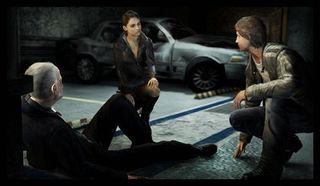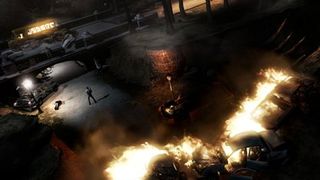The actual driving's pretty simple, and if you know what you're doing and can avoid falling into fissures over and over, this scene is amazing. And it ends by depositing you in Central Park, the huge, freely explorable area in which the real meat of the game lies. It's also filled with cool stuff you can use to your advantage, not the least of which are propane-equipped food carts - which you can turn into rolling, zombie-bursting firebombs - and lots of abandoned cars, which you can use exactly like the real thing. That means you can not only drive them, but shift around to any seat, look for hidden items and raid the glove box for anything that might be useful.

Of course, if you really wanted to, you could skip directly to Central Park, ignoring all that stuff we just talked about. Hell, you could skip just about anywhere in the game. In what's perhaps its most original move, Alone in the Dark is going to be structured like a TV series - or, more specifically, like a DVD of a TV series. Each chapter of the game is an "episode" divided into "scenes," and you're free to access these at any time, with full license to skip over a part you're stuck on, or even tackle the scenes completely out of order. And if you're coming back to the game after a long time away, the "Previously…" story recaps before each play session will help you remember what it was you were supposed to be doing.
If this sounds lame, take heart: it's meant to make the game accessible to everyone, and you don't have to take advantage of it. In fact, it's probably better if you don't, since you won't actually be able to see how the story ends until you've completed at least a heavy portion of it for yourself. And if you skip around, you might even miss out on why Edward Carnby - who's the same Edward Carnby that hunted 1920s-era horrors in the first three Alone in the Dark games - has suddenly woken up in modern-day Manhattan, missing his memory and not looking a day over 40.

Interestingly, almost all of the cool stuff we saw in the 360 version - the explorable cars, the dynamic inventory, the free-roaming park - will appear in the Wii and PS2 versions as well. Some things had to be scaled back, as neither system can handle cool stuff like Natural Motion physics, and the game looks more than a little fugly beside its next-gen counterpart. But this isn't just a watered-down port, either, as the Wii/PS2 versions were developed separately and will feature unique puzzles and challenges that play to their strengths.
Of course, with the Wii version, you also get the Wii controls, which - despite taking some time to get used to - did a few cool things. For example, to open your inventory, you'll perform a gesture that feels like pulling a jacket open, while driving means you'll have to hold the Wii remote and Nunchuk at 10 and 2 and move them as though you were holding a steering wheel.

All three versions look promising, and it'll be interesting to see if Alone in the Dark can actually reinvent the survival-horror genre when it hits on June 24 (the PS3 version won't ship until sometime this fall). So far, though, its early scenes have made a pretty good case for it, and while our hands-on session was sometimes confusing, it still left us wanting more.
Hear more atTalkRadar.
May 23, 2008

